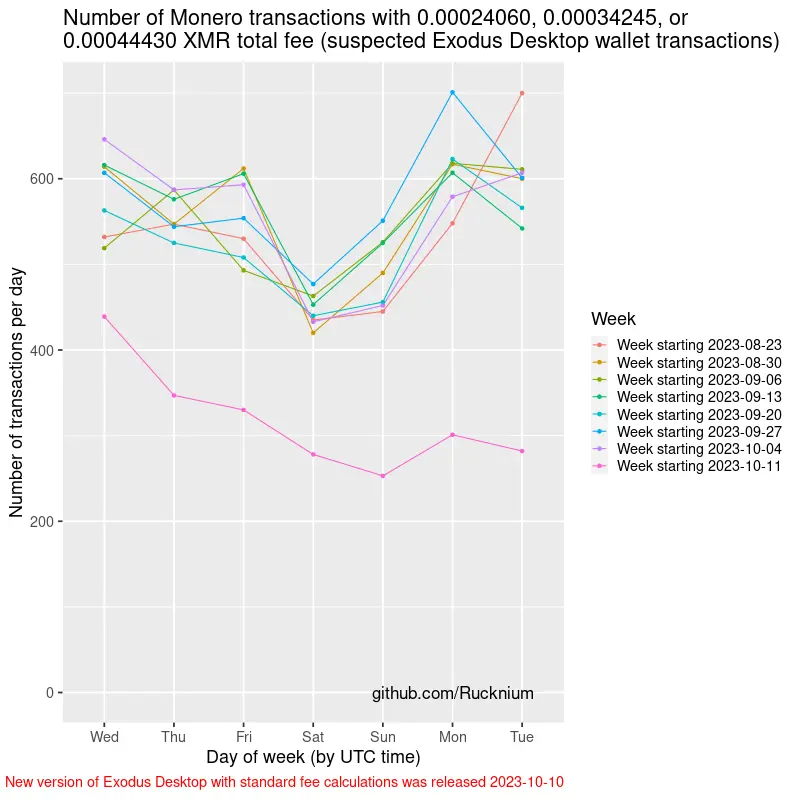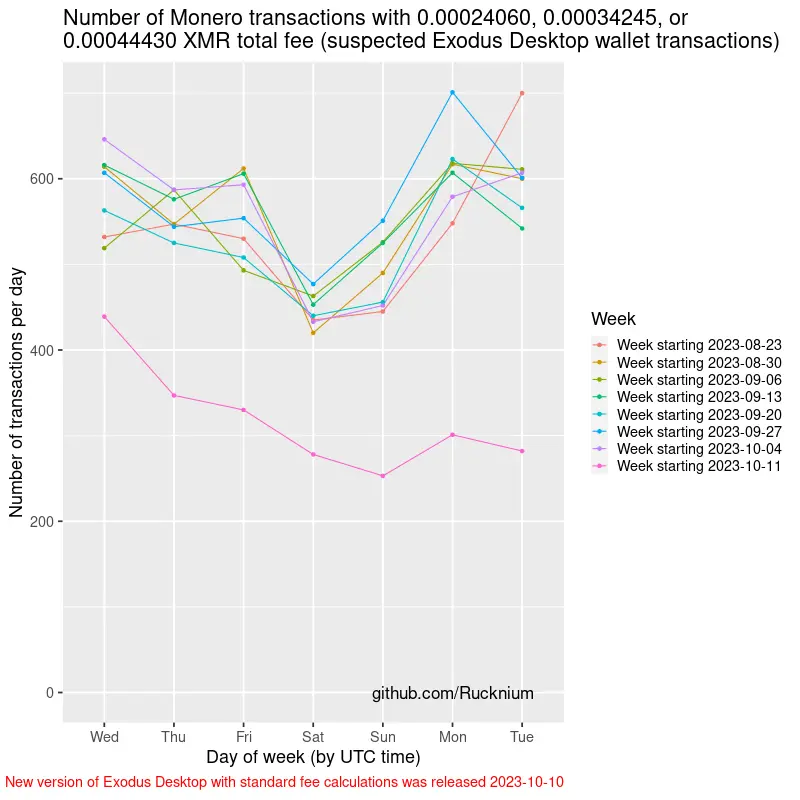-----BEGIN PGP SIGNED MESSAGE-----
Hash: SHA512
[Privacy Advisory]
Exodus Desktop Monero users, update to latest version for privacy fix
Prior to version 23.10.10, which was released on October 10, 2023,
Exodus Desktop wallets produced unusual fees when creating Monero
transactions. I suggest all Exodus Desktop users to update their
software to version 23.10.10 or later before making their next
Monero transaction to avoid the privacy impact of these unusual
fees. The Exodus _Mobile_ wallet also produces unusual fees, but
a fix has _not_ yet been developed and deployed to a new release
version of Exodus Mobile. The fee of all Monero transactions can
be viewed in plaintext by any observer of the blockchain, including
privacy adversaries. Transactions that use unusual fees distinguish
themselves from the rest of transactions on the blockchain.
Two transactions that have the same unusual fee are statistically
more likely to be made by the same user. Unusual fees can increase
the probability of correctly guessing that two transactions are
actually linked to a probability far above random guessing, which
is one divided by Monero's ring size (1/16 = 6.25% correct guessing
when guessing completely randomly). According to my new theoretical
and empirical research that has not been peer reviewed, a privacy
adversary can use a simple statistical classification rule to achieve
a 37% probability of correctly guessing the "real spend" in a ring
signature of a transaction created with pre-23.10.10 versions of the
Exodus Desktop wallet.[1,2]
Unusual fees affect the privacy provided by Monero's ring signature
feature, which obscures the senders of transactions. It does not
affect stealth addresses, which provide privacy for the transaction
recipients, nor does it affect confidential transactions, which hide
the amount of XMR that is being sent.
[1] Rucknium (2023) "Discussion Note: Formula for Accuracy of Guessing
Monero Real Spends Using Fungibility Defects."
https://github.com/Rucknium/misc-research/tree/main/Monero-Fungibility-Defect-Classifier/pdf
[2] Rucknium (2023) "Monero Nonstandard Fees."
https://github.com/Rucknium/misc-research/tree/main/Monero-Nonstandard-Fees
-----BEGIN PGP SIGNATURE-----
iQJMBAEBCgA2FiEEXV4Iojid8iWr0HgbKR4MIp1jFpcFAmUn38AYHHJ1Y2tuaXVt
QHByb3Rvbm1haWwuY29tAAoJECkeDCKdYxaXSaYP/0AKcROZbWqvPCFro3Z2CZTp
0IwmadtgY3OcLhlC8Bno05Rz9P8t6msF0rG51SapK2xtDq+uyM6PFJTqyly9IAVy
TncM79OlbBGFrC8U7HRGfElQbIxzE42ejrRbyTDxwh//dqUfX/3M56O1YOuto+HZ
eLwj3MfQO1sgsIMG5g3/vzp73Vet9+LXf1U3AJVIWlY1Vb7W6r8qvW/LGojT4CCw
/X1f3mkfnlr6CerT8evVlr9A2NYkDnl11pU2JJI2e3ZOgqPhvdJg6/7vFAhxp03d
XvItDpHTssKNagfFc3TScJAYj8S7kkaJsqcQ1Y7vlbGjyqIcg7HuArHMLmDuD84j
egtdFW3I+TD0ZPOeFFbo/mJEgogD+tZoe8ICGZzSLAAj5w8d9XlIfoDEionRas6j
MuGPizBhmwRLBNYvhciqjs1zQSAhQyj+wcx7hOLHpXX6JP5fFT1AH8InRJP9IKiT
UTC4KfofMTSCBZWgFdFTemo5soL+4O6kh2nY8v1QMbXWYXJPqs4WES4yuG+2P5io
xFLExzCZbRq6TeoQGw+iC+GTq2y0yDaLQzp34dIdL/YdIoRRLOBe7m1rLalm+wrL
Ys9ztAOKNFtg8vIY9Qe5VIwniW7WM2aQ0HXM/OyYg6/7EJ2MqvJt+edkDrQMAd9o
bf+PgNKASOmjuFkbMAPm
=cFy3
-----END PGP SIGNATURE-----
Q&A
Q: Does the unusual fee issue affect the Exodus Mobile wallet?
A: Yes. The Exodus Mobile wallet currently uses nonstandard Monero fees that are actually different from the fees used by old versions of the Exodus Desktop wallet. The latest version of the Exodus Mobile wallet does not have a fix for its unusual fees. Users of the Exodus Mobile wallet should be aware that their Monero transactions have lower privacy.
Q: I have sent Monero transactions with the Exodus Desktop wallet prior to the fix. Can those past transactions affect my privacy now?
A: Potentially yes. The fee data is part of every transaction permanently included in the Monero blockchain and cannot be removed. The unusual fee data can be accessed by anyone running a Monero node. If you used Exodus Desktop wallet to send Monero transactions in the past, you may consider if a higher average probability (37%) of your potential adversaries guessing the real spend in your transactions is a problem in your threat model.
Q: What makes the fees unusual?
A: Except when Monero's dynamic block/fee algorithm is raising block size and fees, a Monero node will suggest these four values for fees in units of nanoneros per byte: 20, 80, 320, 4000. A nanonero is 0.000000001 XMR. These four fee levels are "standard" fees. The Exodus Desktop wallet created Monero transactions with 240600, 342450, and 444300 nanoneros fee total (about 160 nanoneros per byte for transactions with 1, 2, and 3 inputs). The new 23.10.10 version of the Exodus Desktop wallet creates transactions with 20 nanonero per byte fees.
Q: How many Monero transactions were sent by an Exodus Desktop wallet?
A: I estimate about 3% of recent transactions had the Exodus Desktop nonstandard fees. That's about 4,000 Monero transactions per week. https://github.com/Rucknium/misc-research/tree/main/Monero-Nonstandard-Fees
Q: Does the Exodus Desktop wallet fix have anything to do with the version 0.18.3.1 of the Monero GUI/CLI wallet that was just released?
A: No. The timing was a coincidence.
Q: How was the issue discovered and patched?
A: I discovered the issue when I analyzed the fee data on Monero's blockchain. A set of nonstandard fees of 160 nanoneros per byte started to appear on the blockchain over a year ago on August 25, 2022, the same date that Exodus released a new version that restored the ability to send Monero transactions. With that clue, I used the Exodus Desktop wallet to create Monero transactions and concluded that it was responsible. I reported the issue to Exodus on September 4, 2023 through HackerOne. Exodus developers wrote a patch that was included in the periodic new version release on October 10, 2023.
Q: Is there any way to reduce the nonstandard fee issue in the Monero protocol instead of hoping that individual wallet developers do not use nonstandard fees?
A: Maybe. The next proposed major upgrade to the Monero protocol, Seraphis, requires that transactions choose from a limited set of possible fees. This is called "fee discretization". https://gist.github.com/UkoeHB/f508a6ad973fbf85195403057e87449e#transaction-uniformity
Q: If I am a Monero user, but I never used the Exodus Desktop wallet, does the issue affect me?
A: The old version of the Exodus Desktop wallet may have created "black marble" effects for other users, but the impact would be very minor because only about 3 percent of all Monero transactions were created by the Exodus Desktop wallet. I have not tried to calculate what the exact effect could be. More info on "black marble" effects: https://reddit.com/r/Monero/comments/12kv5m0/empirical_privacy_impact_of_mordinals_monero_nfts/ . Wallet implementations that use the "wallet2" code to create Monero transactions will use standard fees. As far as I know, some of the wallets that use wallet2 are the GUI, CLI, Feather, Cake, Monerujo, and Stack wallets.
Q: Are there other wallet implementations that produce nonstandard fees?
A: According to the data on the Monero blockchain, yes. There are at least 4 other clusters of nonstandard fees that make up about 7 percent of recent transactions. Figuring out which wallets are creating the transactions requires testing wallets and services like centralized exchanges. You can help! Test wallets and services you use to see if they are producing nonstandard fees: https://github.com/Rucknium/misc-research/tree/main/Monero-Nonstandard-Fees


Do you know about Primo? I think it was only a proof-of-concept, never used widely: https://monero.stackexchange.com/questions/11752/what-is-primo-private-monero-payments